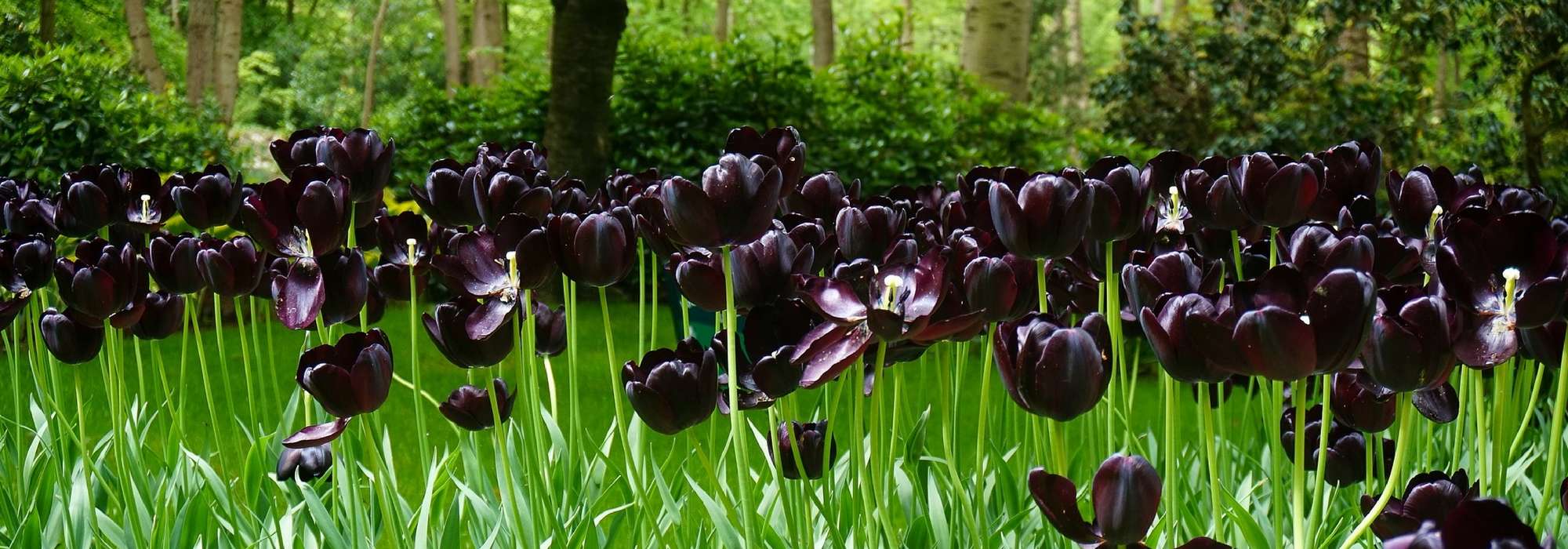
20 black flowers, natural, for your garden
our tips and ideas for pairing them well
Contents
Black flowers, natural, have always fascinated. Among the most sought-after are the black rose, elegant and mysterious, as well as the black tulip, another mythical flower that has inspired generations of horticulturists.
By the way, did you know that the term “black flower” is a misnomer? Indeed, pure black does not exist in the horticultural world. The various shades come close, varying with the light to create the illusion, but they never quite reach perfect black.
But is it really that important? I invite you to discover my selection of 20 black flowers or nearly black, original and enchanting, along with my ideas and tips for successfully pairing them in the garden.
Roses and black-flowered bushes
-
The rose ‘Black Baccara’
‘Black Baccara’ is THE black rose par excellence. The first wave of roses appears almost black depending on the lighting, from the bud to the fully opened flower. In the height of summer, its large double flowers are a very dark garnet red and velvety.
They hold perfectly in a bouquet, lasting from 6 to 10 days if the base of the stem is cut daily. This rose bush has an upright, somewhat stiff and formal habit, while its roses are very lightly scented, content to be admired. Finally, its cultivation is a bit delicate; avoid scorching full sun and provide it with a suitable, rich soil so that it can give its best.
Its roses are beautifully complemented by the foliage of bronze fennel, yarrow, gypsophila, or grey foliage.
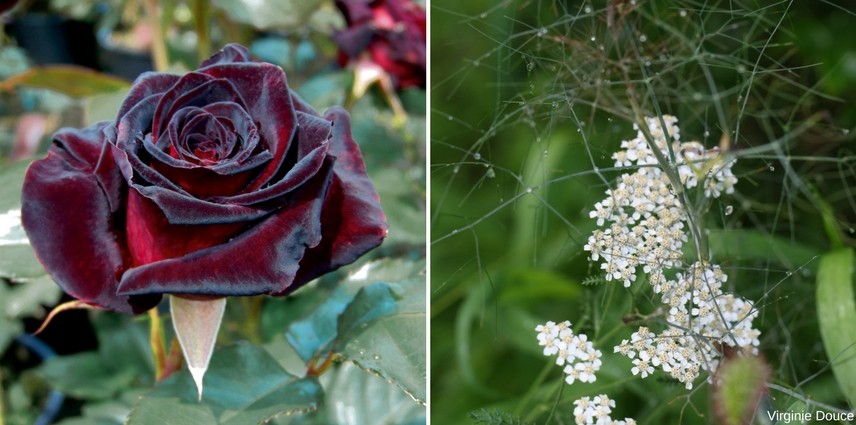
An idea for pairing: Rose ‘Black Baccara’, Foeniculum vulgare ‘Giant Bronze’ and Achillea millefolium ‘Heinrich Vogeler’.
In May-June, it adorns itself with very small, very dark red flowers, almost insignificant, but they do have the merit of being black. The formation of small fruits follows the flowering. It also has very beautiful evergreen foliage, initially green, then it takes on bronze, chocolate purple with silver highlights. Not very hardy, Pittosporum is rather reserved for the Mediterranean climate where it will thrive in a rockery or a well-exposed border. However, it is possible to grow it in a pot on a terrace and bring it indoors for protection in winter. This small bush prefers dry, low-calcium soils, in a warm atmosphere and sheltered from the wind.
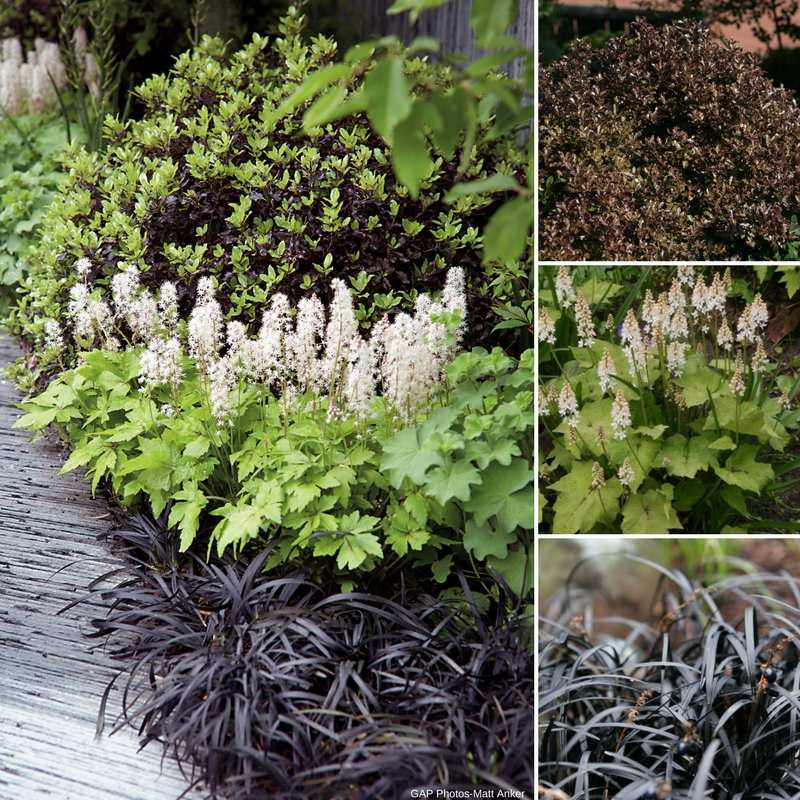
An example of a contrasting association in a border: Pittosporum tenuifolium ‘Tom Thumb’ / Tiarella cordifolia / Ophiopogon planiscarpus ‘Nigrescens’.
Black flowering perennials
-
Agapanthus ‘Black Magic’
This variety of agapanthus, with its unique and fascinating colour, is one of the darkest. It does not go unnoticed with its black bell-shaped buds of a beautiful dark blue, almost black.
Its umbels are particularly graphic and will adorn the garden throughout the summer. In colder regions, be sure to protect the stumps with a thick layer of mulch or grow them in pots to bring indoors during winter.
 A contrasting pairing idea: Combine Pittosporum tenuifolium ‘Irene Patterson’ with Agapanthus ‘Black Magic’. Add some Cistus monspeliensis that will bloom before the agapanthus.
A contrasting pairing idea: Combine Pittosporum tenuifolium ‘Irene Patterson’ with Agapanthus ‘Black Magic’. Add some Cistus monspeliensis that will bloom before the agapanthus.
-
Centaury ‘Black Sprite’
How can one resist this unusual blue flower? This Centaurea ‘Black Sprite’ boasts a dark burgundy colour, almost black, contrasting with its semi-evergreen silver-green foliage.
Centauries are easy-to-grow, robust perennials. Every gardener should have a little mountain cornflower in their garden!
![]() A wild effect pairing idea: Centaurea montana ‘Black Sprite’, Stipa tenuifolia, Centaurea montana ‘Amethyst Dream’ and Atriplex hortensis.
A wild effect pairing idea: Centaurea montana ‘Black Sprite’, Stipa tenuifolia, Centaurea montana ‘Amethyst Dream’ and Atriplex hortensis.
-
Oriental Hellebore ‘Black Chocolate’
Oriental hellebores are very popular, and rightly so! They are easy-to-grow perennials with incredible charm, unfurling their lovely skirts when there is almost nothing else in the garden. The ‘Black Chocolate’ variety has everything to please. Its dark brown, almost black colour contrasts beautifully with its golden stamens.
 A tone-on-tone pairing idea: Helleborus orientale ‘Black Chocolate’, foliage of Euphorbia amygdaloïdes ‘Purpurea’, Ophiopogon planiscapus ‘Nigrescens’, young shoots of peony Paeonia suffruticosa ‘Black Beauty’ (Photos by Virginie Douce, except for the hellebore).
A tone-on-tone pairing idea: Helleborus orientale ‘Black Chocolate’, foliage of Euphorbia amygdaloïdes ‘Purpurea’, Ophiopogon planiscapus ‘Nigrescens’, young shoots of peony Paeonia suffruticosa ‘Black Beauty’ (Photos by Virginie Douce, except for the hellebore).
Its foliage can turn purple, creating an irresistible tableau.
-
Iris chrysographes ‘Black Knight’
The Iris chrysographes ‘Black Knight’ has a rare rich colour with an incredible satin black hue!
This rhizomatous perennial spreads slowly. The acid green tones reveal its beauty; pair it with alchemilla or euphorbias for a contrasting combination.
 A contrasting pairing idea: Euphorbia amygdaloides ‘Purpurea’, Iris chrysographes ‘Black Knight’ and Alchemilla mollis.
A contrasting pairing idea: Euphorbia amygdaloides ‘Purpurea’, Iris chrysographes ‘Black Knight’ and Alchemilla mollis.
Pink flowers also suit it well; the combination is blessed with a carpet of Phuopsis stylosa and purple heuchera like ‘Beaujolais’.
-
Aquilegia vulgaris ‘Black Barlow’
This columbine does not go unnoticed with its very double dark burgundy flowers, almost black. It blooms from May to July and self-seeds. It looks best in partial shade or in non-burning sunlight.
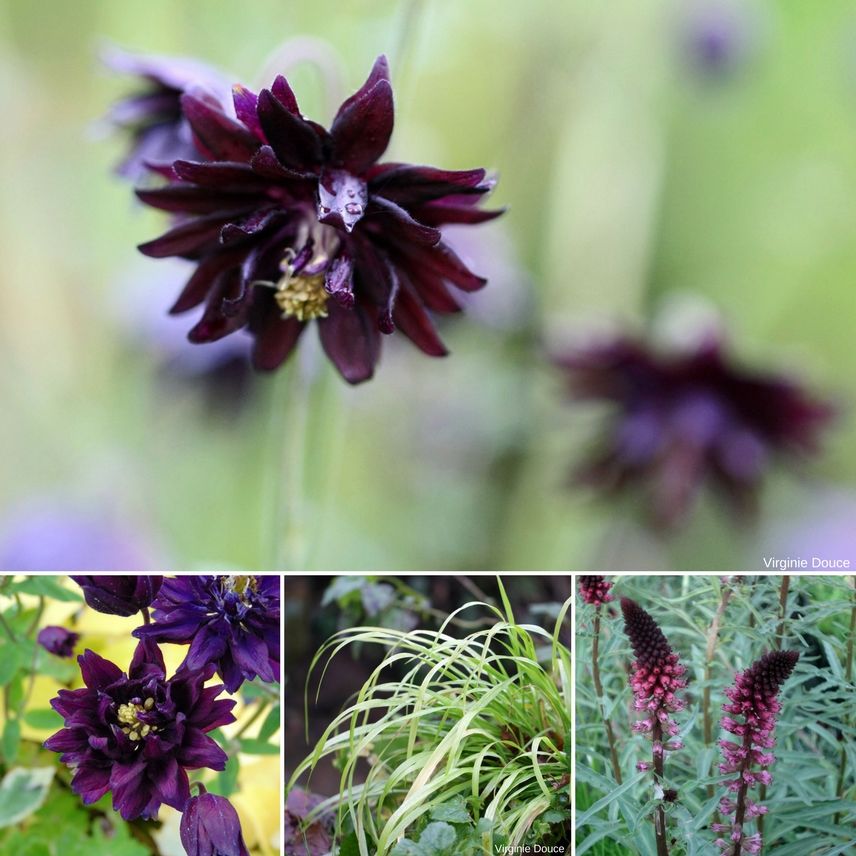 An example of a pairing in cool soil: Aquilegia vulgaris ‘Black Barlow’, Aquilegia vulgaris ‘Clementine Dark Purple’, Millium effusum ‘Aureum’ and Lysimachia atropupurea ‘Beaujolais’.
An example of a pairing in cool soil: Aquilegia vulgaris ‘Black Barlow’, Aquilegia vulgaris ‘Clementine Dark Purple’, Millium effusum ‘Aureum’ and Lysimachia atropupurea ‘Beaujolais’.
-
Primrose ‘Silver Lace Black’
This variety of primrose offers very dark brown petals edged in white with a yellow centre, blooming from May to July depending on your climate. Its flowers will bring originality and graphic appeal to a semi-shaded corner of the garden.
This perennial or biennial is hardy and very floriferous. Plant it at the edge of a path to admire it at leisure, alongside heucheras, brunneras, violas, hostas… It can also be grown in pots or window boxes to add colour to a window, for example.
[caption id=”attachment_41273″ align=”aligncenter” width=”856″>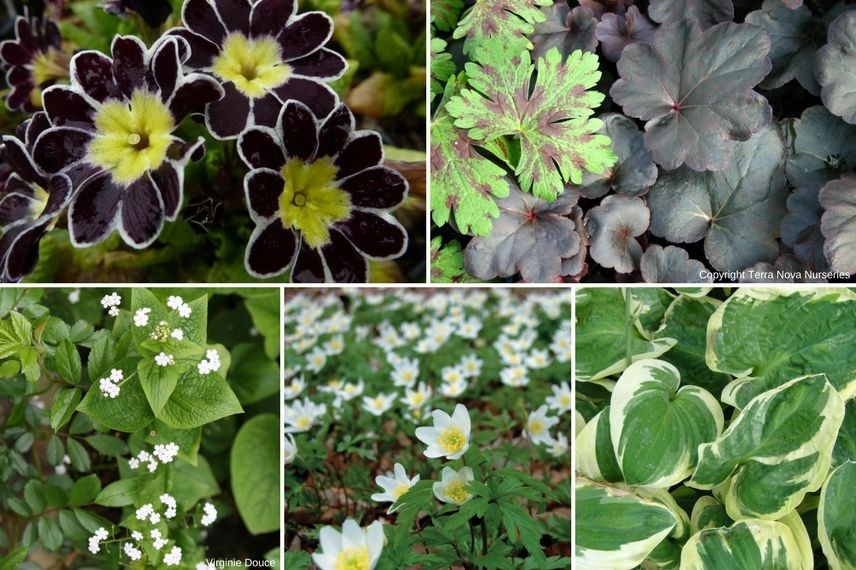 A pairing idea for a shaded atmosphere: Primula elatior ‘Silver Lace Black’, Heuchera ‘Obsidian’, Geranium phaeum ‘Samobor’, Brunnera macrophylla ‘Betty Bowring’, Anemone nemorosa, Hosta ‘Snow Cap’.
A pairing idea for a shaded atmosphere: Primula elatior ‘Silver Lace Black’, Heuchera ‘Obsidian’, Geranium phaeum ‘Samobor’, Brunnera macrophylla ‘Betty Bowring’, Anemone nemorosa, Hosta ‘Snow Cap’.
-
Horned Violet ‘Molly Sanderson’
Very floriferous, this small violet features slightly fragrant flowers with satin-black petals illuminated by a small yellow eye. It blooms from April to September, thanks to the succession of flowers from self-seeding. Its rapid growth and persistence make it an excellent ground cover in non-burning sun or partial shade.
[caption id=”attachment_41277″ align=”aligncenter” width=”856″> A pairing idea: Viola cornuta ‘Molly Sanderson’, Festuca glauca, Viola cornuta ‘Icy but Spicy’.
A pairing idea: Viola cornuta ‘Molly Sanderson’, Festuca glauca, Viola cornuta ‘Icy but Spicy’.
-
Scabious ‘Chile Black’
This black scabious is adorned with small dark chocolate purple pom-poms, perched on thin stems. This short-lived perennial blooms all summer, delighting pollinators and self-seeds easily in the garden. Grow it in the sun in well-drained soil. It pairs wonderfully with grasses and can be used in bouquets.
[caption id=”attachment_41369″ align=”aligncenter” width=”856″>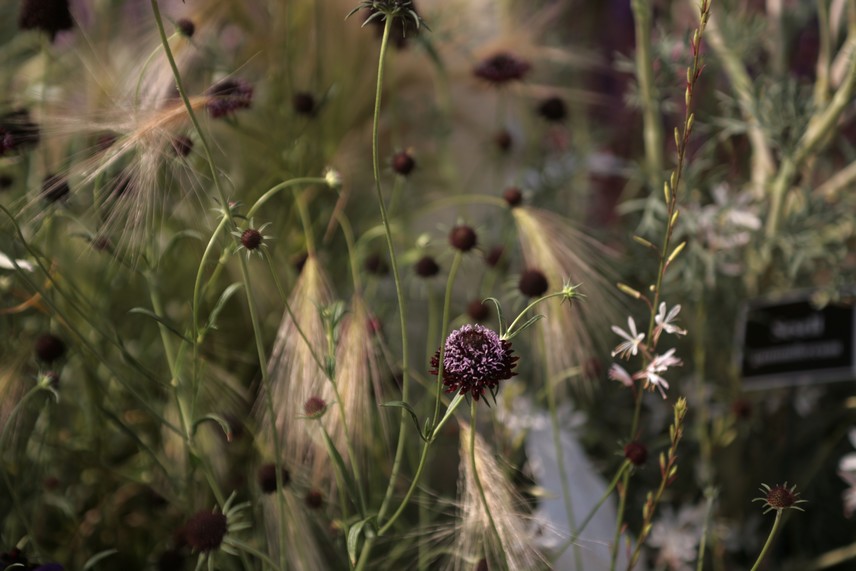 An example of a contrasting and wild pairing in a dry garden: Scabiosa atropurpurea ‘Chile Black’, Hordeum jubatum, Gaura lindheimeri ‘Snowbird.
An example of a contrasting and wild pairing in a dry garden: Scabiosa atropurpurea ‘Chile Black’, Hordeum jubatum, Gaura lindheimeri ‘Snowbird.
Discover other Black flowering perennials
View all →Available in 0 sizes
Available in 1 sizes
Available in 1 sizes
Available in 1 sizes
Available in 1 sizes
Available in 2 sizes
Available in 1 sizes
Available in 1 sizes
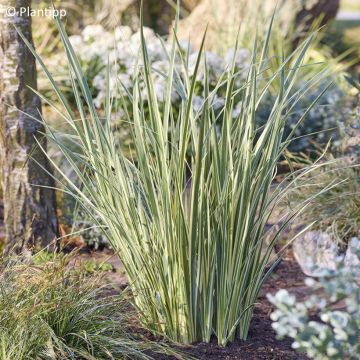
Available in 1 sizes
Available in 1 sizes
Black flowering bulbs and rootstocks
-
Tulip ‘Queen of Night’
This variety of tulips is undoubtedly the darkest of the black tulips. Its flowers are a beautiful, very dark velvety purple with ash reflections. Perched on tall, sturdy stems, they are perfect for enhancing bouquets.
It is a late variety, best paired with other pastel-flowering tulips for a beautiful colour harmony and/or earlier tulips to extend the flowering period. Another significant advantage in the garden is that it reliably returns each year without degenerating.

A simple yet effective combination: Tulip ‘Queen of Night’, Forget-me-not, Tulip ‘Angelique’.
-
Tulip ‘Black Hero’
The tulip ‘Black Hero’ features dark purple double flowers with petals that are almost black. They open into beautiful cups reminiscent of peony flowers.
Its reflections are enhanced in the sunlight. Like the tulip ‘Queen of Night’, this beautiful late variety enjoys being paired with other pastel-coloured tulips.
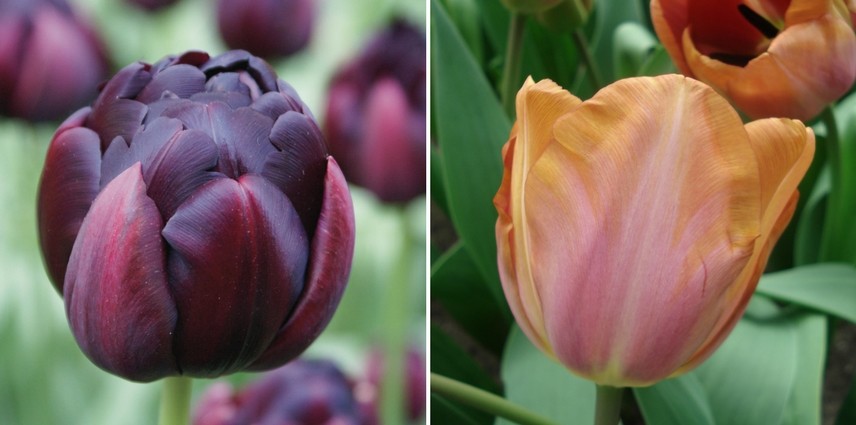
A happy pairing: Tulip ‘Black Hero’ and Tulip ‘Malaika’.
-
Persian Fritillary ‘Adiyaman’
In April-May, the fritillary ‘Adiyaman’ raises sturdy floral spikes amidst beautiful glaucous foliage. Its bells are a deep purple, almost black. Be sure to plant it in the sun. It adds a touch of verticality to your spring beds, among tulips or daffodils.
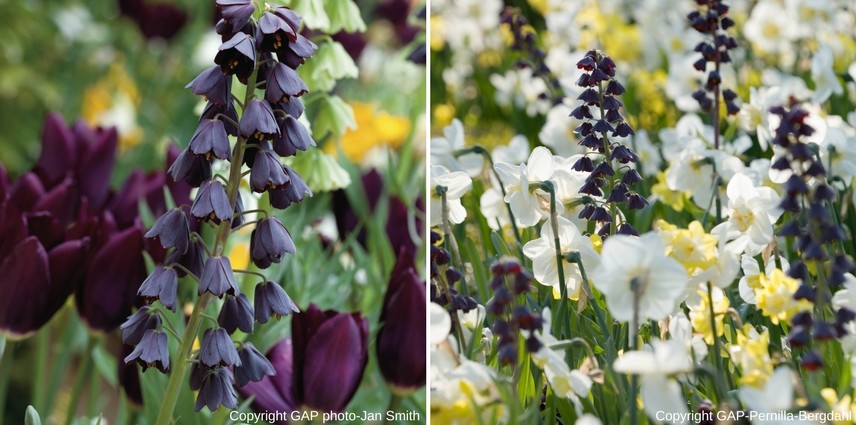
On the left: Fritillaria persica ‘Adiyaman’, Fritillaria persica ‘Ivory Bells’ and Tulip ‘Havran’ – On the right: Fritillaria persica ‘Adiyaman’ mixed with daffodils.
-
Black Calla Lily, Zantedeschia ‘Schwartzwalder’
The black calla lily features very dark violet-purple flowers in summer. Its white-speckled foliage is highly decorative. It can be grown in the ground (moist) but its small size (40cm) makes it suitable for pot cultivation, ensuring proper watering. They can be used in bouquet arrangements.
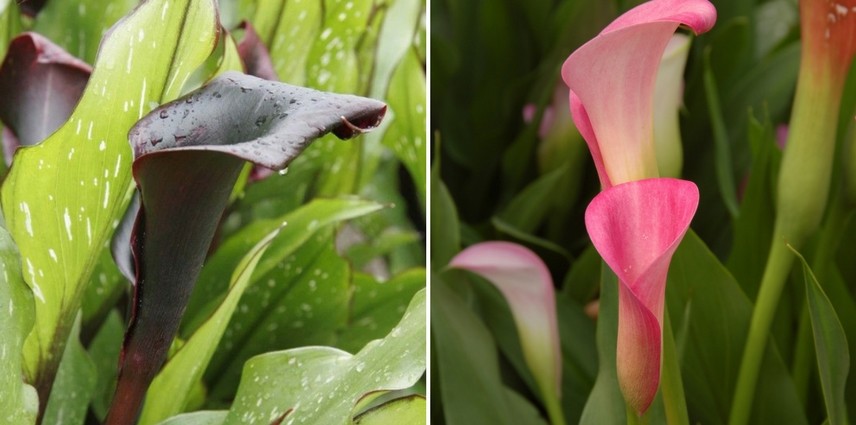
An idea for pairing: Zantedeschia ‘Schwartzwalder’ and Zantedeschia ‘Rehmanii’.
-
Iris germanica ‘Black Suited’
The Iris germanica ‘Black Suited’ is certainly the blackest variety. Its large black flowers with violet reflections emit a delightful musky fragrance in May-June.
It will thrive best in full sun in light, well-drained soil. It is preferable to plant them scattered in a bed rather than in mass. Its flowers are highly valued for bouquet arrangements.
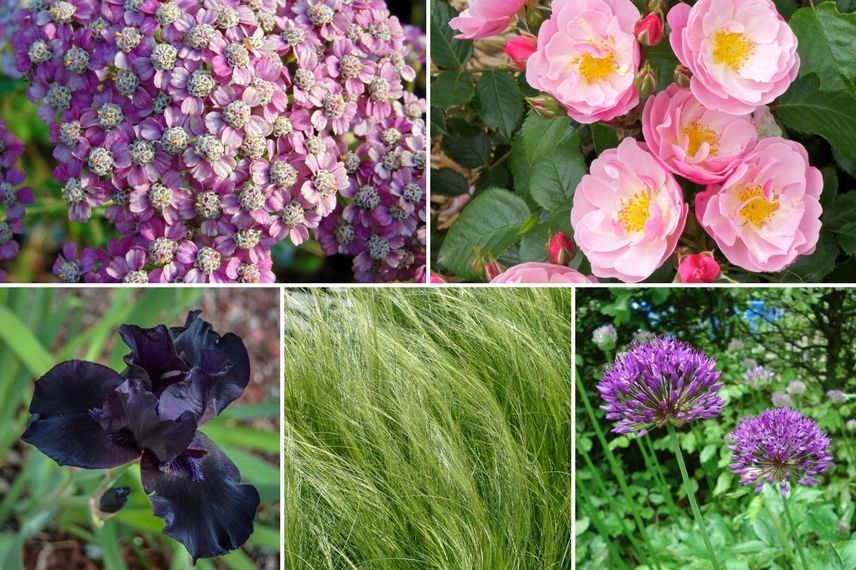
An example of pairing: Achillea millefolium ‘Excel’, Rose ‘Utopia’, Iris germanica ‘Black Suited’, Stipa tenuifolia, Allium ‘Purple Sensation’.
-
Iris germanica ‘Ghost Train’
This large iris also features large flowers of a very dark violet-black with bluish reflections in May-June. It is very vigorous and particularly floriferous.
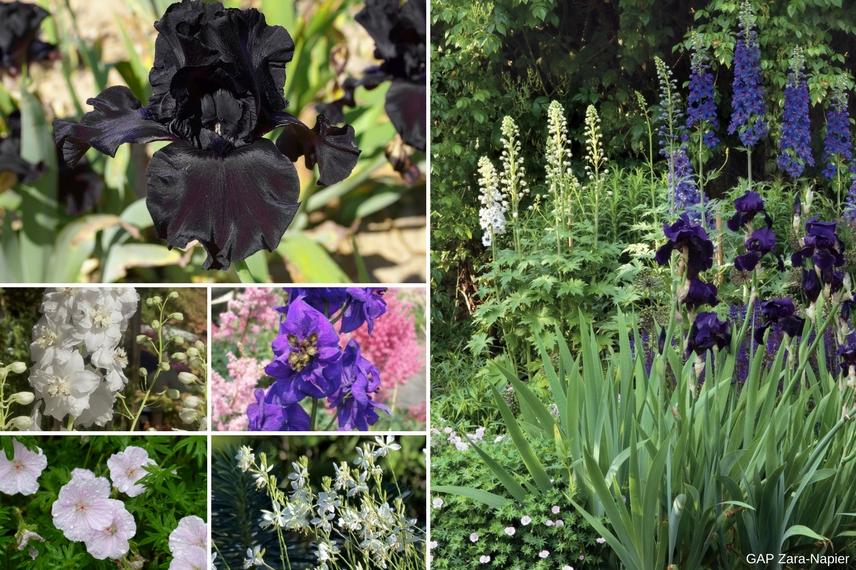 An idea for pairing: Iris germanica ‘Ghost Train’, Delphinium ‘Pacific Black Night’, Delphinium ‘Pacific Galahad’, Geranium sanguineum ‘Striatum’ and why not add a Gaura lindheimeri ‘Snowbird’.
An idea for pairing: Iris germanica ‘Ghost Train’, Delphinium ‘Pacific Black Night’, Delphinium ‘Pacific Galahad’, Geranium sanguineum ‘Striatum’ and why not add a Gaura lindheimeri ‘Snowbird’.
Annuals and biennials with black flowers
-
The Poppy ‘Black Peony’
This opium poppy (papaver somniferum) features large, frilly flowers in such a dark purple that they appear black in summer. They are borne on tall stems with glaucous foliage. Once the flowering is over, the seed capsules remain very decorative and can enhance bouquets.

A pairing idea: Papaver somniferum ‘Black Peony’, Atriplex hortensis, Linaria purpurea ‘Canon J. Went’ and Papaver somniferum ‘Nigrum’.
-
The Nemophila menziesii ‘Pennie Black’
Nemophilas are lovely annual ground covers with small, almost black, violet-purple flowers for the ‘Pennie Black’ variety. It can be planted in the foreground of a semi-shaded bed, brightening it all summer long. The soil should remain cool. If you wish to pair it, opt for Corydalis that enjoy the same growing conditions. It is also delightful grown alone in a cup-shaped pot. The light green, dentate foliage is also very decorative.
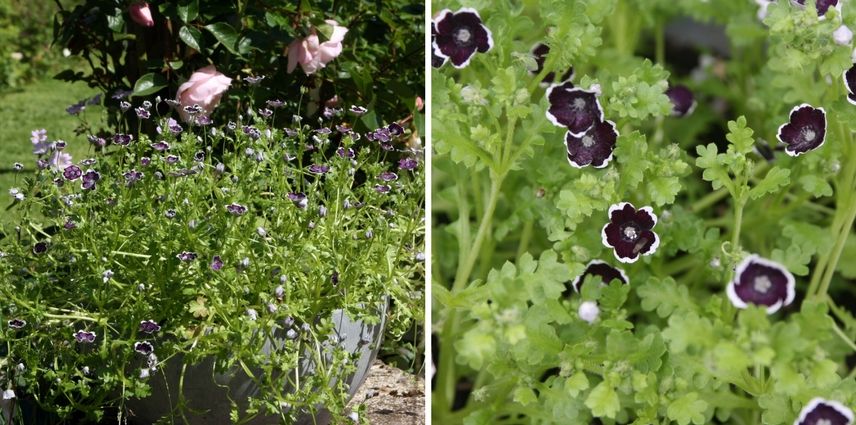
The Nemophila menziesii ‘Penny Black’ is well-suited for pot cultivation. (Photos: Virginie Douce)
-
The Hollyhock ‘Nigra’
Originality is the key word to describe this hollyhock! Indeed, the alcea rosea ‘Nigra’ features satin-like, chocolate-purple flowers that are almost black, perched on tall stems.
Hollyhocks are staples of cottage or country gardens, brightening them throughout the summer. They add a touch of verticality at the back of a bed, against a wall, or even a fence. They self-seed, sometimes in unexpected places.
Against the wall of a house or fence, you can pair it with other hollyhocks in softer pastel colours. Consider staking it if the location is windy.
At the back of a bed, place it alongside another pastel colour, behind a rose bush for example.
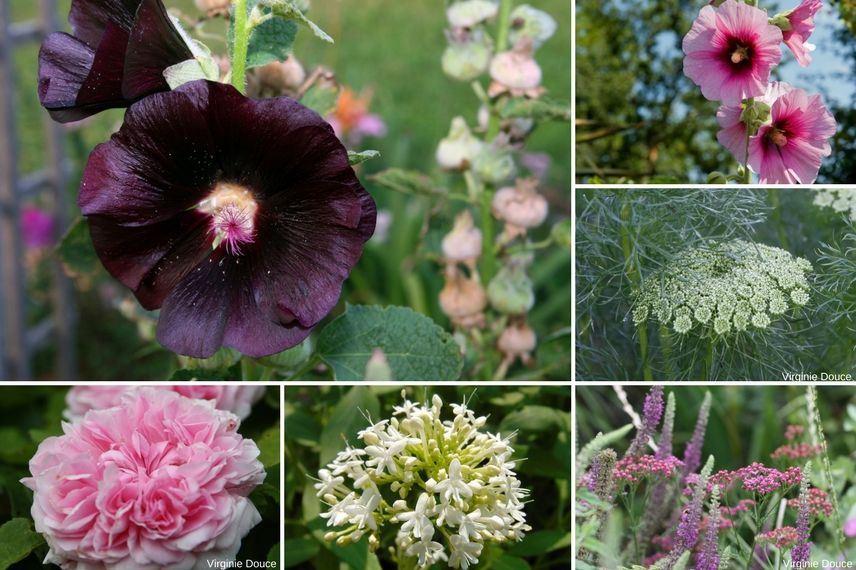
A pairing idea in a bed: Alcea rosea ‘Nigra’, Alcea rosea, Amni visnaga ‘The Giant’, Teucrium hircanicum, Achillea millefolium ‘Cerise Queen’, Centranthus ruber ‘Albus’, Rose ‘Jacques Cartier’.
-
The Petunia ‘Black Ray’
Continuously, this petunia offers an exceptional flowering with large black trumpet-shaped flowers that have silky reflections. Plant it alone in a hanging basket or in a pot with a euphorbia ‘Diamond Frost’ or in a bed, accompanied by silver foliage.

A pairing idea: Nepeta faassenii, Petunia ‘Black Ray’ and Artemisia arborescens ‘Powis Castle’.
How to use black in the garden?
To use black flowers in the garden, you can choose to play with contrasts or harmonise the whole and play with tones on tones.
-
Playing with Contrasts
Black flowers can be paired with white flowers, silver foliage, or chartreuse green, which will enhance each other.
-
Playing with Tones on Tones
You will notice that black flowers are actually a very dark purple or violet colour. To harmonise the colours, you can play on this and choose a similar, lighter shade. You can also play with dark foliage.
Black flowers also pair well with pastel colours like pink or mauve.
-
The Importance of Exposure
Brightness enhances or attenuates the intensity of black. Very dark flowers are also significantly more beautiful away from the scorching sun.
-
Don’t Overdo the Black
Beware of the “too much” effect! Use black sparingly. Unless your goal is to create a gothic garden, a few carefully measured touches to add a hint of whimsy and create surprise are sufficient.
Discover and get inspired by our “All Black” theme.
- Subscribe!
- Contents
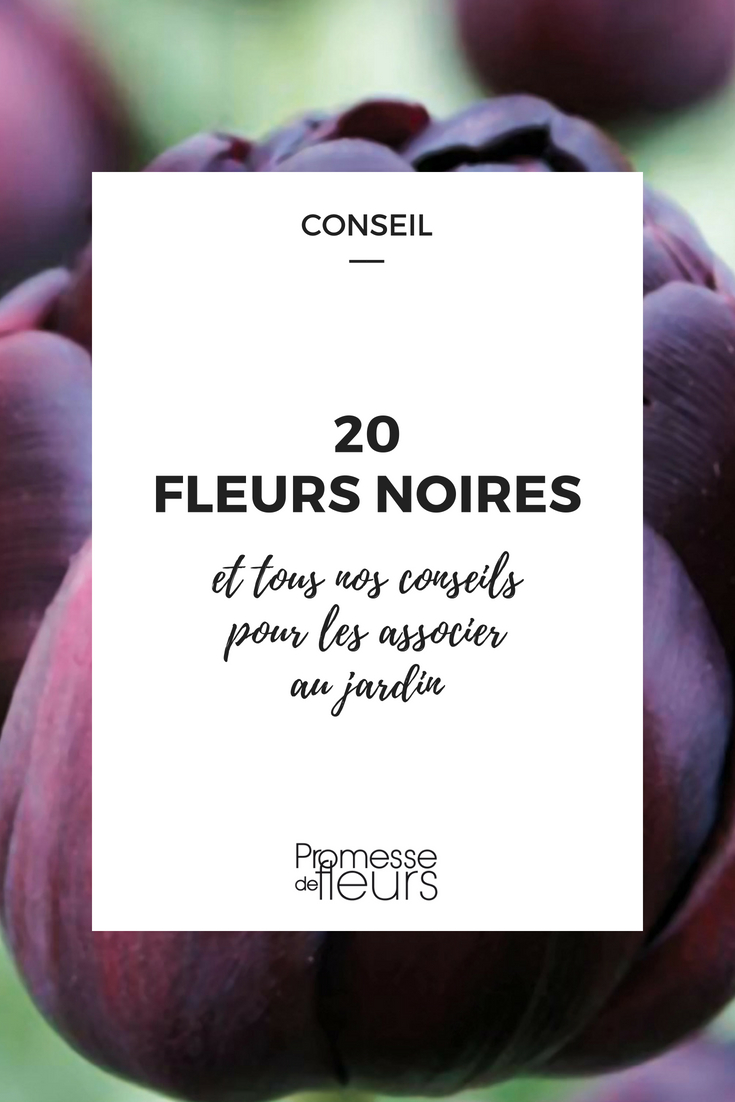

































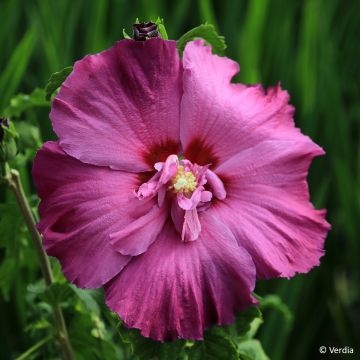
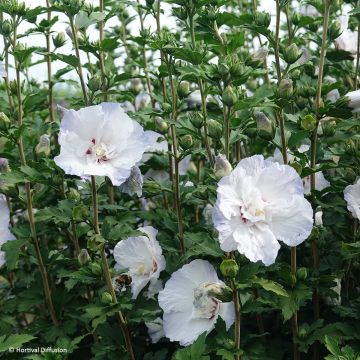


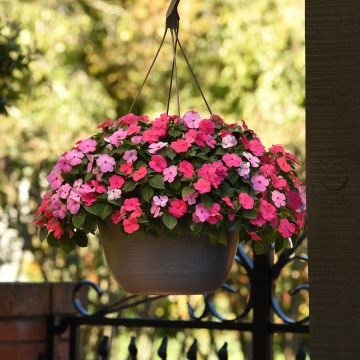

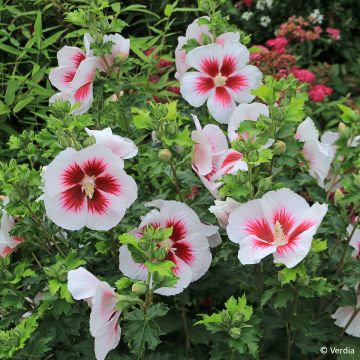
Comments